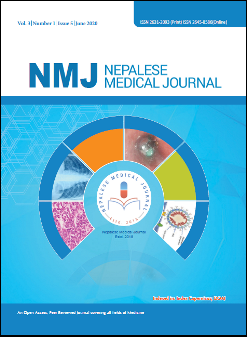COVID-19 Pandemic and Nationwide Lockdown: How it Influenced Histo-cytopathology Practice?
DOI:
https://doi.org/10.3126/nmj.v3i1.28988Keywords:
COVID-19, Histocytopahtology, LaboratoryAbstract
Introduction: The 2019 novel coronavirus global pandemic compelled nationwide lockdown in Nepal with attendance of only urgent consultations and surgeries. This study aims to assess the volume, diagnostic categories, and age distribution of cases received in a histo-cytopathology laboratory so that laboratories can be prepared accordingly, to cope with a probable surge of COVID-19 or similar incidence in Nepal.
Materials and Methods: A retrospective descriptive study was performed in the Pathology Department, Patan Academy of Health Sciences during first four weeks of nationwide lockdown from March 24 to April 24, 2020. The current data was compared with that of March 24 to April 24, 2019.
Results: The volume of histopathology specimens was reduced by one-fifth and cytological samples by one-seventh. In histopathology, non-neoplastic lesions were 269 and 65, benign lesions 48 and 1, and malignancy 27 and 6 cases in the corresponding period of the previous year and COVID-19 lockdown period respectively. Appendix, product of conception, placenta, and tubal ectopic pregnancy constituted a major bulk of histopathology cases. The percentage of malignant cases reported in histopathology, as well as cytology, increased during the COVID-19 pandemic. The mean age of patients was 37 years during the COVID-19 lockdown and 41 years in the previous year.
Conclusions: Despite the reduction in the overall volume of histo-cytopathology samples, a higher rate of malignancy was recorded. This emphasizes the necessity of continuing histo-cytopathology services and delivering timely diagnosis even during such a contagion crisis so that oncological patients are not deprived of appropriate management.
Downloads
Downloads
Published
How to Cite
Issue
Section
License
This license enables reusers to distribute, remix, adapt, and build upon the material in any medium or format, so long as attribution is given to the creator. The license allows for commercial use.
Copyright on any article published by Nepalese Medical Journal is retained by the author(s).
Authors grant Nepalese Medical Journal a license to publish the article and identify itself as the original publisher.
Authors also grant any third party the right to use the article freely as long as its integrity is maintained and its original authors, citation details and publisher are identified.




